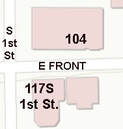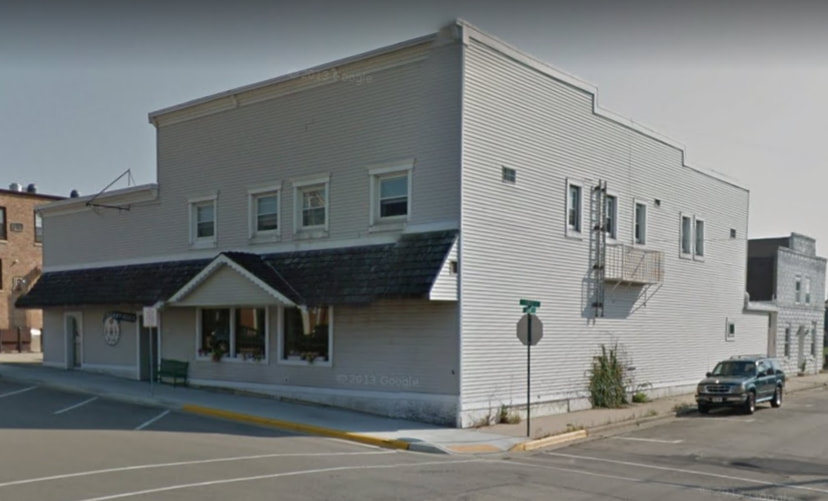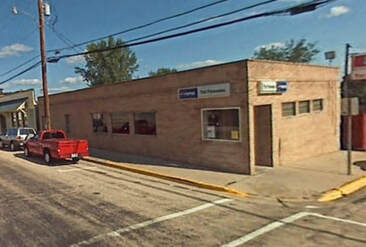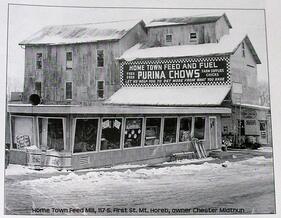104 East Front Street (rear of 111 South First Street) (People's Mercantile Assoc. Warehouse) - demolished
|
104 East Front Street
This vernacular concrete building was built as machinery warehouse for the People's Mercantile Association, a general store, in 1913 (The Mount Horeb Centennial Book, 1861-1961, p. 50, 59, Village of Mount Horeb Tax Rolls). It has a Boomtown Front, and features smooth- and rock-faced concrete blocks, decorative blocks at the cornice and a flat pediment. The People's Mercantile Association bought the site in 1900 from Martin Breum, and operated a general store here until 1920. Officers over time included L. Post (1901-11), Bennett Barton (1901-1917), P.R. Post (1901-11), Harvey Fargo (1913-17), John Hersig (1919-21) and James Malone (1919-21). The business became the Farmers Store in 1921, and was operated as a department store by 1928. Lyle M. Kittleson was the manager of the Farmers Store from 1921 until 1949, when Alton Knudtson and Bill Thousand purchased the stock and fixtures. They renamed the business Farmers Market, but Kittleson owned the building and it remained a part of his estate as late as 1955. In 1950, Harold Churchill bought the business (The Mount Horeb Centennial Book, 1861-1961, p. 61). The property was owned by People's Mercantile Association from 1900 thorough 1920, by the Farmers Store from 1921 until at least 1950, by Lyle M. Kittleson and later his estate from at least 1955 until at least 1960. It was owned by Walter Kalscheur from at least 1965 until at least 1975. The property has been owned by Peter Riphahn since at least 1980. The People's Mercantile Association Warehouse is probably eligible for designation as a Mount Horeb Historic Site for its architecture, and is a contributing element in the potential National Register Main Street Historic District, and the potential locally-designated Main Street Historic District. |
117 South First Street (Clarence Labansky Meat Market)
|
117 South First Street
This astylistic utilitarian brick-veneered building was erected for Clarence Labansky and Ralph Lukken in 1966 (Village of Mount Horeb Tax Rolls). Half of the building housed Labansky's meat market, and half housed the law offices of Harry Cook and Wallace Kalbakken. The east half has been a beauty shop since 1970 (Mount Horeb Presettlement to 1986, p. 29). This is the former site of Hometown Feed and Fuel. In 1881, Rowland and Blied had a grain elevator built on the east side of South First Street just north of the railroad tracks. By 1883, it was owned by J.B. Canterbury and Company (Blue Mounds Weekly News, July 31, 1883). From at least 1888 until at least 1891, Adolph Elver and Company was operating the elevator, which then included a sorghum mill. From at least 1893 until at least 1895, John Bohn was the proprietor. Bohn was in partnership with Christian Finke by 1897, and with Finke and John Ward by 1901. From 1901 until at least 1905, John Ward, John Bohn, and C.A. Finke also owned the electric company, which was located in, and supplied current for, their mill (The Mount Horeb Centennial Book, 1861-1961, p. 45; Wisconsin State Gazetteer and Business Directory). Finke was on his on from at least 1907 until at least 1909, and in partnership with his son from at least 1911 until at least 1915. The property was operated by J.C. Fjelstad from at least 1917 until 1931 (Wisconsin State Gazetteer and Business Directory). P.J. Dunlap took over the Mount Horeb Feed and Fuel Company in 1931. In 1950, Chester and Tenny Midthun purchased the business from George Lukken and changed the name to Home Town Feed and Fuel (The Mount Horeb Centennial Book, 1861-1961, pp. 57, 59). The feed mill was razed in 1966 (Village of Mount Horeb Tax Rolls). This property was owned by Hometown Feed and Fuel in 1965; by Labansky and Lukken in 1966; by Labansky and Hoffmaster in 1970; by Hoffmaster, and Cook and Kalbakken in 1975; by Wendell Hoffman, and Cook and Kalbakken from at least 1980 until at least 1985, and by Harry Cook and Dale Beck since at least 1989 (Village of Mount Horeb Tax Rolls). The Labansky Building is not individually eligible for historic designation. |





